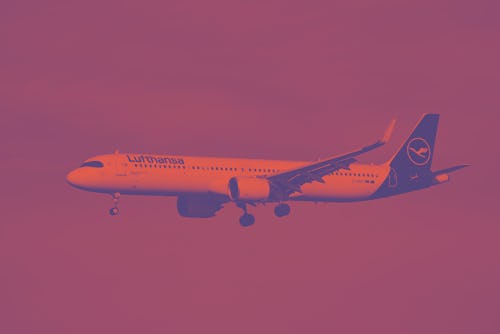"Ghost flights" are wreaking havoc on the environment for no good reason
The European Union is facing scrutiny over a policy that requires airlines to fly empty planes across the region to keep their takeoff and landing slots.

When you see a plane flying overhead, you probably imagine it’s full of passengers — or, at least, partially so. But as it turns out, that’s not always the case. Across the globe, thousands of flights known as “ghost flights” take place every year with no one onboard — the result of pre-pandemic regulations that require carriers to perform a minimum number of their scheduled flights or risk losing key slots at airports.
In the European Union, this policy is being newly scrutinized after airlines have admitted to operating ghost flights on the regular. Lufthansa Group — the parent company of several regional carriers including Austrian Airlines, Brussels Airlines, Eurowings, Lufthansa, and Swiss International Airlines — has flown 18,000 flights without a single passenger on board this winter alone.
The reason for this: They kind of have to. Under current EU regulations, airports throughout the region have a “use it or lose it” policy for takeoff and landing slots. Prior to the COVID-19 pandemic, carriers were required to fulfill at least 80% of their scheduled flights. Failing to do so would put an airline at risk of losing those reserved spots, which are essential to staying on schedule. For the airports, the logistics of scheduling hundreds of flights each day means there’s no time to mess around with an airline that’s wasting slots that could otherwise be utilized.
The EU cut back on these requirements when the pandemic hit and air travel came to a screeching halt, but it didn’t nix the regulations entirely. Instead, it cut the “use it” level to 50% — which is still pretty high, considering air travel was down 60% globally, according to the International Civil Aviation Organization. So, rather than resign themselves to the “lose it” fate, carriers have been sending planes on their way with nary a passenger on board; burning fossil fuels and creating carbon emissions for no reason other than to maintain the right to continue to do just that.
It’s not just Europe that has skies full of empty planes, either. In the United States, a similar policy requires carriers to meet 80% of their scheduled takeoffs and landings. That policy was waived back in October 2020, but it seems airlines have nonetheless been shifting their empty planes around the country. A report from energy trade publication E&E News found that while the number of passengers in late 2020 had declined by 96% from the year prior, airlines had only reduced the number of flights by 58% during the same period — suggesting that plenty of planes were traveling with few or no passengers onboard.
The EU is now exploring the possibility of further tweaking its “use it or lose it” rule, per The Independent, with industry groups seeking more flexibility to keep these wasteful flights out of the air. For airlines, the motivation is financial: Fuel is expensive, and running these flights without a single ticket sold is costing them money. But these flights are also harming the planet. Air travel is responsible for about 2.5% of our global carbon emissions, and burning fuel for no reason other than to meet outdated and arbitrary requirements isn’t helping anyone.
Some air travel is necessary, or at least understandable, and many airlines have promised they’ll attempt to minimize their environmental impact (though they’re more talk than action so far). Ultimately, we’re best served by cutting out unnecessary flights, pandemic or not. To that effect, a number of EU countries have proposed bans on short-haul flights where rail alternatives are available. That’s a good start. So is cutting out ghost flights, lest we be haunted by these wasteful practices.